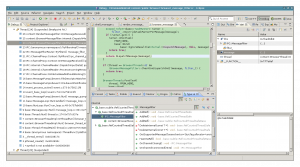Move semantics can be very useful to transfer ownership of resources, but as many other C++ features, it’s one more double edge sword that can harm yourself in new and interesting ways if you don’t read the small print.
For instance, if object moving involves super and subclasses, you have to keep an extra eye on what’s actually happening. Consider the following classes A and B, where the latter inherits from the former:
#include <stdio.h>
#include <utility>
#define PF printf("%s %p\n", __PRETTY_FUNCTION__, this)
class A {
public:
A() { PF; }
virtual ~A() { PF; }
A(A&& other)
{
PF;
std::swap(i, other.i);
}
int i = 0;
};
class B : public A {
public:
B() { PF; }
virtual ~B() { PF; }
B(B&& other)
{
PF;
std::swap(i, other.i);
std::swap(j, other.j);
}
int j = 0;
};
If your project is complex, it would be natural that your code involves abstractions, with part of the responsibility held by the superclass, and some other part by the subclass. Consider also that some of that code in the superclass involves move semantics, so a subclass object must be moved to become a superclass object, then perform some action, and then moved back to become the subclass again. That’s a really bad idea!
Consider this usage of the classes defined before:
int main(int, char* argv[]) {
printf("Creating B b1\n");
B b1;
b1.i = 1;
b1.j = 2;
printf("b1.i = %d\n", b1.i);
printf("b1.j = %d\n", b1.j);
printf("Moving (B)b1 to (A)a. Which move constructor will be used?\n");
A a(std::move(b1));
printf("a.i = %d\n", a.i);
// This may be reading memory beyond the object boundaries, which may not be
// obvious if you think that (A)a is sort of a (B)b1 in disguise, but it's not!
printf("(B)a.j = %d\n", reinterpret_cast<B&>(a).j);
printf("Moving (A)a to (B)b2. Which move constructor will be used?\n");
B b2(reinterpret_cast<B&&>(std::move(a)));
printf("b2.i = %d\n", b2.i);
printf("b2.j = %d\n", b2.j);
printf("^^^ Oops!! Somebody forgot to copy the j field when creating (A)a. Oh, wait... (A)a never had a j field in the first place\n");
printf("Destroying b2, a, b1\n");
return 0;
}
If you’ve read the code, those printfs will have already given you some hints about the harsh truth: if you move a subclass object to become a superclass object, you’re losing all the subclass specific data, because no matter if the original instance was one from a subclass, only the superclass move constructor will be used. And that’s bad, very bad. This problem is called object slicing. It’s specific to C++ and can also happen with copy constructors. See it with your own eyes:
Creating B b1 A::A() 0x7ffd544ca690 B::B() 0x7ffd544ca690 b1.i = 1 b1.j = 2 Moving (B)b1 to (A)a. Which move constructor will be used? A::A(A&&) 0x7ffd544ca6a0 a.i = 1 (B)a.j = 0 Moving (A)a to (B)b2. Which move constructor will be used? A::A() 0x7ffd544ca6b0 B::B(B&&) 0x7ffd544ca6b0 b2.i = 1 b2.j = 0 ^^^ Oops!! Somebody forgot to copy the j field when creating (A)a. Oh, wait... (A)a never had a j field in the first place Destroying b2, a, b1 virtual B::~B() 0x7ffd544ca6b0 virtual A::~A() 0x7ffd544ca6b0 virtual A::~A() 0x7ffd544ca6a0 virtual B::~B() 0x7ffd544ca690 virtual A::~A() 0x7ffd544ca690
Why can something that seems so obvious become such a problem, you may ask? Well, it depends on the context. It’s not unusual for the codebase of a long lived project to have started using raw pointers for everything, then switching to using references as a way to get rid of null pointer issues when possible, and finally switch to whole objects and copy/move semantics to get rid or pointer issues (references are just pointers in disguise after all, and there are ways to produce null and dangling references by mistake). But this last step of moving from references to copy/move semantics on whole objects comes with the small object slicing nuance explained in this post, and when the size and all the different things to have into account about the project steals your focus, it’s easy to forget about this.
So, please remember: never use move semantics that convert your precious subclass instance to a superclass instance thinking that the subclass data will survive. You can regret about it and create difficult to debug problems inadvertedly.
Happy coding!


